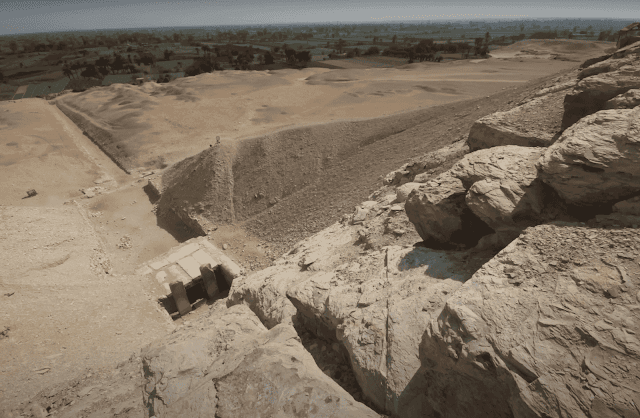Meidum Pyramid in Egypt
The first king of the 4th Dynasty, Sneferu (c. 2613–2589 BC), chose Meidum as the site of his royal tomb. What we see today bears little resemblance to the original monument, which was a step pyramid that was then transformed into a true pyramid with smooth sides.
For this and several other reasons, Sneferu’s reign was a pivotal point of the Old Kingdom, and the site of Meidum is an integral part, representing the developments in pyramid-building know-how, technology, and techniques that would then lead to the building of some of Egypt’s most famous monuments.
At Meidum, Sneferu began building a seven-step pyramid that would have been 65 metres high. This was then enlarged, possibly before completion, into an eight-step pyramid. These two phases are called E1 and E2 by Egyptologists. In a completed state, the E2 pyramid would have been 85 metres high with a base length of 120.75 metres. It was at this point that Sneferu built the massive Bent and Red Pyramids at Dahshur. He then transformed the eight-step E2 pyramid into a true pyramid (E3) which stood between 92 and 95 metres high, with a base length of 144 metres.
Today, the pyramid has the appearance of a three-step structure emerging out of a massive mound of rubble and debris surrounding it. This tower is, in fact, most of the core of the pyramid. It was previously hypothesised that the rubble was the result of a sudden and catastrophic collapse that took place during the E3 construction phase. However, the debris consists of layers—strata—demonstrating that the erosion and destruction of the pyramid was, in fact, gradual.
According to earlier scholarship, the Meidum pyramid was constructed by Sneferu’s predecessor, the last king of the 3rd Dynasty, Huni (c. 2637–2613 BC). This is no longer the consensus. Sneferu’s name appears in texts in Meidum, and the ancient name of this site was Djed Sneferu ‘Sneferu Endures.’ During the reign of Thutmose III (c. 1479–1425 BC) in the 18th Dynasty, the scribe Ankhkheperreseneb visited Meidum and wrote an inscription, saying that he had come ‘to see the marvellous temple of Horus Sneferu. He saw it, as if heaven were in it and in it the sun rose.
The Interior of the Pyramid The entrance into the pyramid is in its north face, as was the standard, but it is unusually around 15 metres above the ground. A descending passage goes from the masonry of the pyramid down into the bedrock, turning into a horizontal corridor. Going past two niches, this leads to a vertical shaft that goes up to the burial chamber. Its corbelled ceiling distributed the tremendous weight of the masonry above, preventing it crushing the open spaces within the pyramid. It is for this same reason that the ancient Egyptians built corbelled weight-relieving spaces just above the two niches and the lower part of the descending passage. These were only discovered in 1998. It is here in Meidum that corbelling for a stone ceiling appears for the first time, a technique that would later be used to outstanding effect in the Grand Gallery and the burial chamber in Khufu’s tomb—the Great Pyramid.
What is the significance of the Meidum Pyramid?
Historical Significance: The Meidum Pyramid offers insights into the early experimentation with pyramid construction methods. Its collapse influenced the development of architectural techniques for later pyramids.
What is interesting about Meidum Pyramid?
The pyramid at Meidum is thought to be just the second pyramid built after Djoser's and may have been originally built for Huni, the last pharaoh of the Third Dynasty, and continued by Sneferu. Because of its unusual appearance, the pyramid is called el-heram el-kaddaab – (False Pyramid) in Egyptian Arabic.
What happened to the Meidum Pyramid?
2575–c. 2465). Late in its reconstruction under Snefru, the outer casing and fill of the pyramid began to collapse. The work was abandoned, and the mortuary chapel remained uninscribed.
Who built the Meidum Pyramid?
The pyramid of Meidum was built during the reign of King Huni and was completed later by his son King Snerfu. It was believed that King Snefru wanted to complete a special Pyramid to honor the ancient Egyptian gods & goddesses and his power and greatness.
Why is pyramid so special?
Pyramids today stand as a reminder of the ancient Egyptian glorification of life after death, and in fact, the pyramids were built as monuments to house the tombs of the pharaohs. Death was seen as merely the beginning of a journey to the other world.
The Meidum Pyramid seems never to have been completed. Beginning with Sneferu and to the 12th Dynasty, all pyramids had a valley temple, which is missing at Meidum. The mortuary temple, which was found under the rubble at the base of the pyramid, apparently never was finished. Walls were only partly polished. Two stelas inside, usually bearing the names of the pharaoh, are missing inscriptions. The burial chamber inside the pyramid itself is uncompleted, with raw walls and wooden supports still in place which are usually removed after construction. Affiliated mastabas were never used or completed and none of the usual burials have been found. Finally, the first examinations of the Meidum Pyramid found everything below the surface of the rubble mound fully intact. Stones from the outer cover were stolen only after they were exposed by the excavations. This makes a catastrophic collapse more probable than a gradual one. The collapse of this pyramid during the reign of Sneferu is the likely reason for the change from 54 to 43 degrees of his second pyramid at Dahshur, the Bent Pyramid.












No comments:
Post a Comment